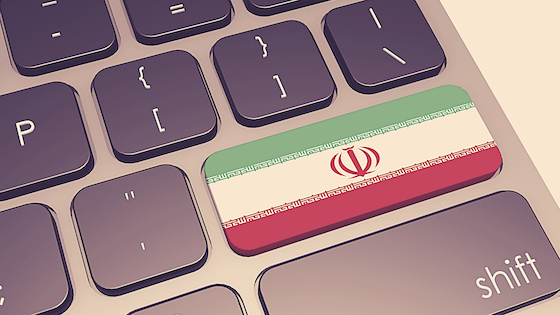>> Lese diesen Blogpost auf Deutsch.
With regard to „digital sovereignty“ in Iran, the English-language source material is rudimentary. Especially after the „Green Movement“ in 2009, the Internet in Iran was examined scientifically (Siboni/Abramski/Sapir 2020, 35) after that, however, a large gap exists. Terms such as „digital sovereignty“ or „technological sovereignty“ are not explicitly mentioned in the English-language literature – however, the Iranian government follows similar patterns to China and Russia and is often cited as an example in the context of the other two states.
Hyland, who has studied Internet censorship in various countries, calls Iran „one of the worst offenders of Internet freedoms“ (Hyland 2020, 15). Starting with the state-run Telecommunication Company of Iran, access to content is regularly censored, and since 2001 the Iranian government has controlled all Internet traffic flowing into the country. Techniques such as deep packet inspection, keyword filtering, DNS hijacking, and protocol-based throttling are also used here (ibid.). Furthermore, work on an Iranian intranet – also called „Halal Internet“ – a closed system similar to the one in China, has been going on for years (ibid., 17).
The first serious case of Internet censorship in Iran occurred in 2001, when Iranian courts granted the government control over Internet service providers. The latter were then subjected to strict monitoring and censorship measures. This was a continuation of a general media censorship strategy that had already been established around 2000. With the U.S. invasion of Iraq in 2003, censorship became even stricter, and Iranian authorities arrested and tortured bloggers critical of the regime. In the wake of the „Green Movement“ in 2009, the Iranian government recognized the protest power emanating from the digital sphere and had dozens of bloggers imprisoned. Facebook and Twitter were blockedDuring further domestic protests in 2017 to 2019, websites and communication platforms were blocked and in some places even internet access was blocked for several days (Siboni/Abramski/Sapir 2020, 35f.). Furthermore, the government forced web providers to sign a declaration of commitment, which precludes the provision of VPN services and proxies (ibid., 27f.).
Since 2005 and 2006, respectively, the Iranian government has pursued a strategy to build a „National Information Network,“ „a national intranet with a nationally managed e-mail system and a local server infrastructure to be used by all Internet companies based in Iran“ (translated from Skierka/Brenner 2015, 48). The idea is to create an IP-based Internet supported by data centers that cannot be detected or accessed by foreign forces. This national network is to be in accordance with Shiite Islamic laws and isolated from the global Internet. „This ‚halal‘ digital ecosystem, free from foreign websites and influence, would allow complete awareness of all Internet traffic in the country – and total control over user data and speech.“ (Brooking/Kianpur 2020, 13) At the beginning of the project, around three years were estimated as the planning and implementation period (Mueller 2017, 49). In 2010, the project was actually launched and in May 2019, the government announced a realization rate of 80 percent (Siboni/Abramski/Sapir 2020, 28 and Brooking/Kianpur 2020, 13).
For around ten years, the Iranian government has been steadily expanding the Internet network – especially in rural regions. As a result, the country is now one of the largest Internet users in the Middle East (Siboni/Abramski/Spair 2020, 36). While unwelcome foreign services such as the messaging provider Telegram are blocked, the development of national alternatives is intensively promoted. For example, the Iranian government provided Soroush and Bale services with technical support and financial aid to develop their platforms. Further, in 2017, a sum of $200,000 was provided to local apps that reached one million users (ibid., 29). In general, the Iranian government supports startups and innovation. At the end of 2019, it invested $225 million in the „Iran Innovation Fund“ to implement this strategy. In addition to financial support, the Iranian government also encourages local citizens through education in the digital field. Various Iranian universities offer hacking classes (ibid., 33). Iran is also innovative in another area: in December 2019, President Hassan Rouhani proposed the creation of a Muslim cryptocurrency „as a means of fighting against American economic hegemony“ (ibid., 35).
You might also be interested in:
- Digital sovereignty – A Problem Outline
- Digital sovereignty in the EU – A brief overview
- Digital sovereignty in China – A brief overview
- Digital sovereignty in Russia – A brief overview
Resources
Brooking, Emerson T.; Kianpur, Suzanne. „Iranian Digital Influence Efforts: Guerilla Broadcasting for the Twenty-first century.“ In: Atlantic Council, 2020, 11-14. < www.jstor.org/stable/resrep24668.6 > (01.06.2021).
Hyland, Jospeh. „Internet Censorship: An Integrative Review of Technologies Employed to Limit Access to the Internet, Monitor User Actions, and their Effects on Culture.“ https://digitalcommons.liberty.edu/cgi/viewcontent.cgi?article=2078&context=honors > 2020. (27.06.2021)
Mueller, Milton. Will the Internet Fragment? Sovereignty, Globalization, and Cyberspace. Cambride, Malden: Polity Press, 2017.
Siboni, Gabi; Abramski, Léa; Sapir, Gal. „Iran’s Activity in Cyberspace: Identifying Patterns and Understanding the Strategy.“ In: Cyber, Intelligence, and Security 4 (1), 2020, 21- 40.
Skierka, Isabel Marie; Brenner, Thorsten. „Digitale Souveränität.“ In: Woyke, Wichard; Varwick, Johannes (Hrsg.). Handwörterbuch Internationale Politik. 13. Auflage. Opladen, Toronto: Verlag Barbara Budrich, 2015, 45 – 49.
